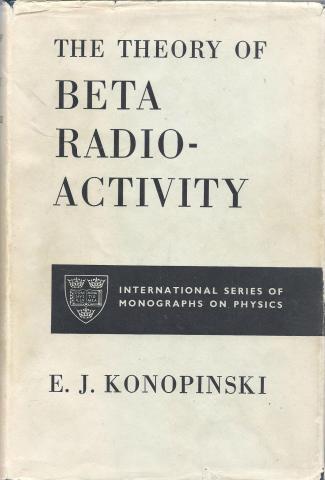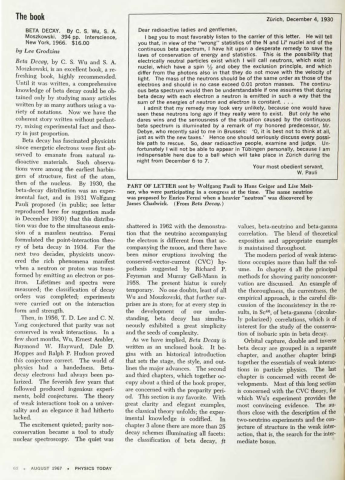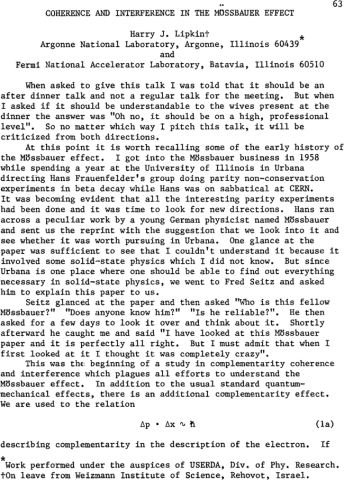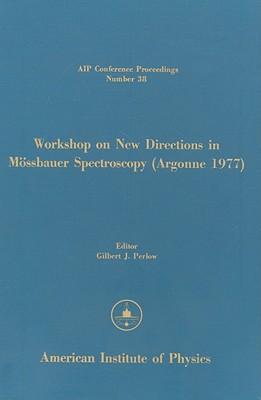The Theory of Beta Radioactivity


Previous speakers have already emphasized the importance of electron-neutrino angular correlations in identifying the basic interactions in β-decay. We have also seen that htere are some serious inconsistencies in the experimental situation. At the same time I should like to say that I can see no strong reason to reject any of these results. In this talk I propose to describe some of the difficulties one encounters in this kind of work and to illustrate these with a dscription of the experiment on Ne23.
A. Salam: So you would be inclined to discount the He6 experiments if you had to choose?
B. W. Ridley: This is rather difficult, because there are always some questions which are left unanswered in any experimental paper, and one can sometimes pick holes in the experiment, but I would not like to do so without the people concerned being here to reply,

Wu's chapter "The Neutrino," summarizing the history of classical recoil experiments, is cited here.
This volume is a beautiful memorial to Wolfgang Pauli and a reminder of the fragility of human fate. As the editors relate, several years ago a volume was planned to celebrate the sixtieth birthday of Pauli; the aim was to summarize the progress in those topics of physics which were near to Pauli's heart, and to discuss Pauli's influence on the development of physics during the 1930's. However, what started as a celebration turned into a memorial with Pauli's untimely death. This change in the course of events makes it understandable that the only contributions which deal with Pauli himself are a brief preface by Niels Bohr and a bibliography of Pauli's papers by C. P. Ens, since no epitaph can be written for a living person. — Nandor L. Balazs, Princeton University
"Man soil keine Irrlehren verbreiten" was one of Pauli's favorite remarks and most contributions were written in this spirit. R. Kronig, W. Heisenberg. and B. L. van der Waerden deal with the early history of quantum mechanics and the exclusion principle. The articles which deal with physics itself fall in several classes. G. Wentzel gives an account of quantum field theories until 1947; the elimination of divergences from quantum field theory is discussed by F. Villars; R. Jost's article is a magnificent exposition of the relation between the exclusion principle and the Lorentz group; the theoretical and experimental developments concerning the neutrino and the nonconservation of parity is the object of C. S. Wu's note; L. Landau contributes a terse discussion on the fundamental problems one encounters in field theories with strong interactions. (There is a remark by Landau on page 246 which could reflect not only his but Pauli's attitude as well: "The brevity of life does not allow us the luxury of spending time on problems which lead to no new results.") H. B. G. Casimir and R. E. Peierls each contribute on solid-state physics. V. Bargmann describes Pauli's work in relativity, omitting, however, one of Pauli's basic contributions to unified field theories, to wit, his brief remark: "What God hath put asunder no man shall join."

Brookhaven/MIT physicist Grodzins reviews the classic 1966 work by Wu and Moszkowski,
Beta Decay, by C. S. Wu and S. A. Moszkowski, is an excellent book, a refreshing book, highly recommended. Until it was written, a comprehensive knowledge of beta decay could be obtained only by studying many articles written by as many authors using a variety of notations. Now we have the coherent story written without pedantry, mixing experimental fact and theory in just proportion.
Fermi formulated the point-interaction theory of beta decay in 1934. For the next two decades, physicists uncovered the rich phenomena manifest when a neutron or proton was transformed by emitting an electron or positron. Lifetimes and spectra were measured; the classification of decay orders was completed; experiments were carried out on the interaction form and strength.
Collaboration between teams from Rice, Argonne and Munich (including Mössbauer himself).
Synchrotron radiation from modern electron storage rings can furnish brighter sources of Mössbauer radiation than radioactive sources if appropriate filtering can be devised. The object is to pass the power in the synchrotron radiation which lies in the spectral range within a few natural widths of the nuclear resonance, with as little diminuition as possible, and to reduce that passed outside this range to a fraction of the filtered radiation.
We consider the methods which can be used to filter, and we make estimates of the efficiency of the various filter schemes.

Harry Lipkin's after-dinner talk at the Argonne 1977 meeting places the history and future of the Mössbauer field into context. The level was not pitched to the "wives [including Helga Ruby] present at the dinner."
This was the beginning of a study in complementarity coherence and interference which plagues all efforts to understand the Mössbauer effect....If the electron is described in a way which loois sharp to a "position measuring" physicist, it looks fuzzy to a "momentum measuring" physicist. If it looks sharp to a "momentum measuring" physicist, it looks fuzzy to a "position measuring" physicist.
At this point it is worth recalling some of the early history of the Mössbauer effect. I got into the Mössbauer business in 1958 while spending a year at the University of Illinois at Urbana directing Hans Frauenfelder's group doing parity non-conservation experiments in beta decay while Hans was on sabbatical at CERN.

Proceedings of important Mössbauer conference at Argonne in 1977 includes two papers by Stan and his part in a panel discussion on uses of synchrotron radiation; also a retrospective talk on the Mössbauer Effect by Harry Lipkin.
TOPICS OF THE WORKSHOP
1. New and neglected techniques, including synchrotron radiation sources, focussing and guiding, resonant Bragg scattering, Rayleigh scattering, selective excitation, techniques for detecting small effects, new uses of ultra-low temperatures.
2. Coherence phenomena.
3. New isotopes of special interest.
4. Relativeity experiments.
5. Mixed Technology: r-f experiments, beta spectrometry, etc.
6. Nuclear physics, electromagnetic moments, charge and moment distrirbution in nuclei, symmetries from Mössbauer experiments, experiments in accelerator beams.
7. Other ideas, experiments, or theory that fit with the framework of the Workshop title.
The Workshop on New Directions on Mössbauer Spectoscopy was organized to fill a need which I and a number of people to whom I spoke felt was no longer being met by the biennieal international conference on Applications of the Mössbauer Effect.

First presented at the 4th Nassau Mössbauer Symposium, January 2006, and later published in the conference proceedings.
Stanley L. Ruby (1924-2004) made major contributions to Mossbauer spectroscopy and was the first to suggest the feasibility of observing the Mossbauer effect using synchrotron radiation. In this article we recall his scientific legacy that have inspired his scientific colleagues.
During his active scientific career, Stanley Ruby always addressed most fundamental aspects of physics without being a "reductionist" - asking questions regarding the fundamental interaction of electromagnetic waves with matter - nucleons, atoms, molecules and the condensed matter, and answering these questions with unique demonstration experiments. This recollection paper is intended to be a brief compilation of Stanley Ruby's selected contributions. They are creation and annihilation of acoustic phonons, chopped gamma-rays, and jump diffusion in condensed matter. In addition, Ruby's nuclear physics background fitted best for him to identify many new candidate nuclear resonant transitions across the nuclear periodic table; and his grasp of chemical physics led to the development of isomer shift systematic among isoelectronic compounds of 5s-5p atoms. Finally, Ruby's most pragmatic suggestion in 1974 to use synchrotron radiation to observe nuclear resonance, and its eventual demonstration, addressed many fundamental aspects of collective nuclear excitation process and gamma-ray coherence. Furthermore it opened many new avenues of application of the tool to a broader area of science which otherwise would have been impossible with the traditional approach of using radioactive sources in performing Mossbauer spectroscopy measurements.